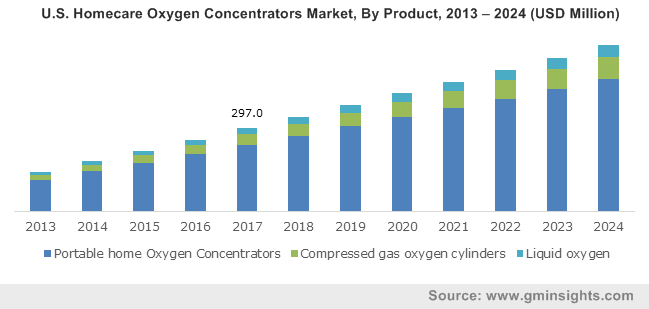Homecare oxygen concentrator market unveiled with respect to the regional landscape: India to emerge as a pivotal regional contender by 2024
Publisher : Fractovia | Latest Update: 2018-12-28 | Published Date : 2017-04-05Request Sample
The global homecare oxygen concentrator market is estimated to register substantial growth in the years to come, primarily on account of the owing to the rising prevalence of chronic respiratory disorders. As a matter of fact, some of the major risk factors that contribute to the causes and consequences of CRDs include smoking, unhealthy diet, indoor and outdoor air pollutants, and allergens. In addition to these factors, CRDs are also results of non-modifiable risk factors like age and heredity.
U.S. Homecare Oxygen Concentrators Market, By Product, 2013 – 2024 (USD Million)

Attributed to the growing impact of current socioeconomic, cultural and environmental determinants such as urbanization, many individuals have lately undergone significant changes in living standards, social behavior, and health. Although urbanization has brought forth a spate of opportunities, it has also led to health risks and hazards, that in a way has been responsible for the expansion of homecare oxygen concentrator market.
Data by the World Health Organization states that between 1995 and 2005, the urban population in developing nations grew by an average of 1.2 million individuals per week or about 165,000 people per day. Currently, over 50% of the world’s population resides in urban areas and by the year 2050, nearly 70% of the world’s population is estimated to reside in towns and cities.
The report further unveils that urban air pollution leads to around 1.2 million deaths each year globally, primarily due to respiratory and cardiovascular diseases attributed to motor vehicles, industrial pollution, and household fuel combustion. On the grounds of the same, products like portable oxygen concentrators, liquid oxygen concentrators, and compressed gas oxygen cylinders can serve as helpful devices for victims of respiratory illnesses, thereby increasing the growth rate of homecare oxygen concentrators market.
Unveiling homecare oxygen concentrator market trends from the U.S.
In terms of regional growth, U.S held the highest market share valued at $297 million in 2017 attributed to a chunk of the population with high disposable income having high affordability for home healthcare services. According to the Centers for Medicare & Medicaid Services Office of the Actuary, the United States is estimated to spend around $103 billion on home health and care in 2018, which is expected to reach $173 billion by 2026. One of the primary drivers of the U.S. homecare oxygen concentrator market being the aging population, followed by other demographic and economic fundamentals, this investment is likely to up the ante for the regional industry.
Incidentally, between 2019 to 2020, the yearly growth rate for home health spending is estimated to reach 6.7% and compared to 2017, home health spending was projected to increase by 5.9 percent in 2018. By 2026, on an average, the total national health spending will surge up to 5.5% annually which will contribute to 19.7% of the U.S economy, unveiled the medical journal Health Affairs. Thus, the geriatric population susceptible to chronic respiratory disorders will drive the demand for portable oxygen concentrators and home oxygen concentrators, which will stimulate the growth of the U.S. homecare oxygen concentrator market.
Unveiling homecare oxygen concentrator market trends from APAC
Moving to the Asia Pacific territory, it is prudent to mention that India has been experiencing an increased prevalence of respiratory diseases due to worsening air pollution levels in the country. As per the Indian Council of Medical Research, one in every death in India is credited to air pollution, which is apparently higher than smoking. Approximately 77% of Indians are exposed to outdoor air pollution levels, beyond the safety limit set by National Ambient Air Quality Standards.
Experts even claimed that an increase in respiratory problems, particularly during winters with peak air pollution have been persistently causing health problems beyond the seasonal prevalence of respiratory illness. Pollution is currently the leading cause of chronic obtrusive lung disease in India and a major contributor to lung cancer.
Health economists of the country claim that the demand for home healthcare services in India is estimated to increase exponentially in a year’s time. The advantages associated with its excellent outcomes at a cost-effective price as patients can save between 20% to 50% on expenditure as compared to regular hospital treatment. The population’s increasing susceptibility to chronic respiratory diseases paired with home healthcare benefits is set to surge the growth of India homecare oxygen concentrators market, that would eventually impel the APAC industry.
The competitive landscape of homecare oxygen concentrators includes key players like O2 Concepts, Inogen, Inova Labs, Yuwell, Air Water Inc, Invacare Corporation, Philips Healthcare among many others. According to a report compiled by Global Market Insights, by the end of 2024 the homecare oxygen concentrators market size is projected to surpass $1.7 billion.